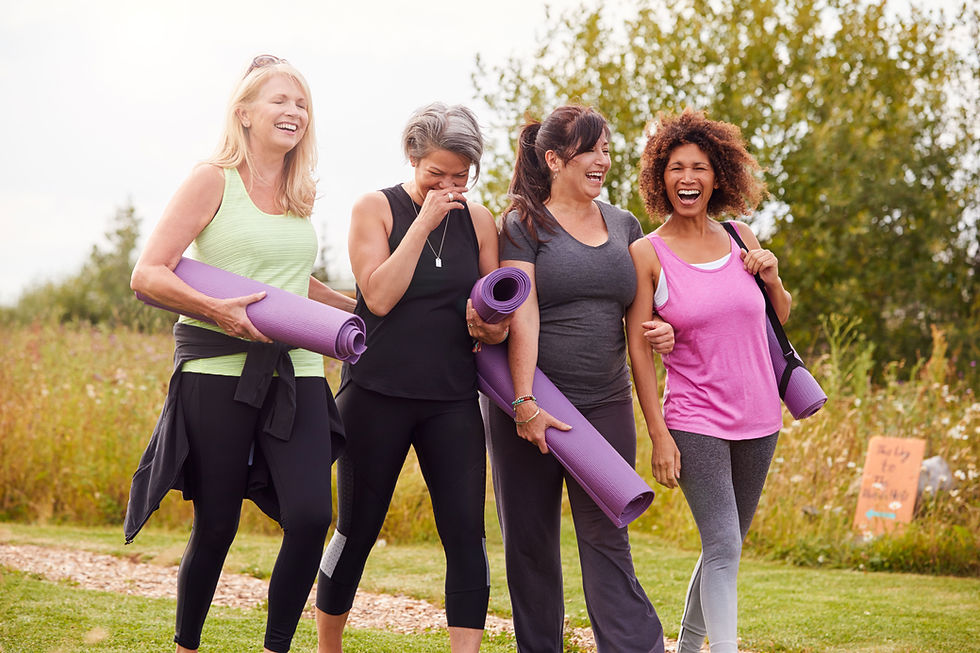How do you do more of the advanced yoga poses if you can't get into them?
- Jessica Lucey

- Oct 4
- 3 min read
No matter how many times I hear this question, I'm still a little thrown off.
I try to eliminate posture hierarchy -- making one pose or variation better than another -- so people feel comfortable choosing the option that's best for them. Not because it's what they think they should do; but because they're acting from a place of care, trust in their abilities, and safety to explore with something different from their neighbor.
So in return, I ask my own question.
What is an advanced yoga pose (asana)?
Most people who ask me about what I do, think an advanced yoga pose (asana) is a headstand, some type of arm balance, or bendy-pretzel shape. I think an advanced yoga pose is whatever allows you to be fully present and connect: to the moment, to yourself, to the environment and community around you.
Is a yoga pose advanced because of a challenging physical aspect or because of the quality of the mind of the practitioner?
Why can't it be both?
To be clear, the purpose of yoga is not to make a bunch of shapes.
According to the Yoga Sutras of Patanjali, the purpose of yoga it's to stop the waves and swirling of the mind-heart so that we can see clearly from purusha (this pure part of you that is unchanging). The difficulty of getting into the shapes can build dedication and focus, which are skills needed to quiet the mind. It can also help you uncover the unconscious thoughts that have been shaping your actions.
The shapes and challenge are a means to an end. In fact, there are more ways to practice yoga than creating the shapes and poses of asana.
Essentially, people really want to know if I'm able to create modifications for folks with limited mobility, and the answer is, "Yes. Yes I can."
Yoga modifications for someone with limited mobility
To modify a yoga pose (asana), figure out what element of the original pose you want to highlight.
For example, crow pose is an arm balance where people draw their knees toward their chest, "stand" on their hands, and balance their knees on their forearms. There are elements of strength by drawing the knees to the chest, the press of the hands on the ground, and spreading the shoulder blades apart. There's also the element of balance. Energetically, there can be a sense of focus, playfulness, or triumph.

Get creative and experiment with integrating one or more of those elements
into the modification.
Continuing with our example, one option would be to do crow pose seated, on the floor. You could draw the knees to the chest, bring the forearms on the knees, and squeeze knees to arms and arms to knees. you can still spread the shoulder blades apart, and press your hands in front of you. Balance comes in by trying to balance on your sit bones. This could be playful because of the balancing aspect, or feel triumphant because you've picked something that you're able to do.

When you need help with modifying your yoga practice
Maybe you have limited mobility or you're getting over an injury. The class you're taking could feel like it's moving too fast and not giving you enough time to settle into the pose. Or maybe you body just doesn't move "that way" because of the way your limbs are proportioned.
Whatever your reason for needing to modify, remember this does not diminish your value or make you less of a yogi. In fact, utilizing a modification is a form of care for yourself, and identifying your need or desire of a modification is a form of discernment. Those are both aspects of yoga beyond the yoga pose.
However, even with knowing the foundations of modifying your yoga asana practice, you might not be able to do it. The ability to modify is limited by experience, creativity, and knowledge.
Working with an experienced yoga teacher can help you overcome those limitations and integrate the rest of the yoga practices beyond asana. A group yoga class can provide different options. Private Yoga provides personalized recommendations for you and unique situation where you can give feedback for whatever modification or yoga you're offered.
When I work with someone in a private yoga class, you're able to share all the unique quarks about your body that are causing you pain, interfere with your movement, or make yoga difficult for you. That information is taken into account with the rest of your habits and lifestyle to create a practice that's tailored for you. Your feedback about your experience and questions are welcome in order to improve your understanding and effectiveness of your practice.
If this type of personalized care is interesting to you, schedule a free call to get your questions answered and see if private yoga is right for you.


Comments